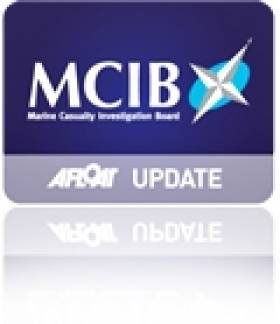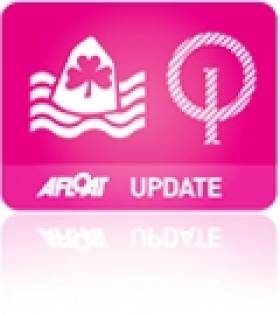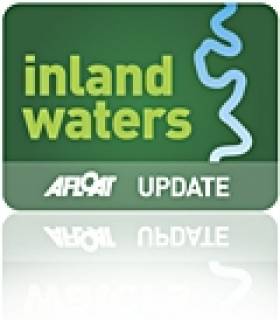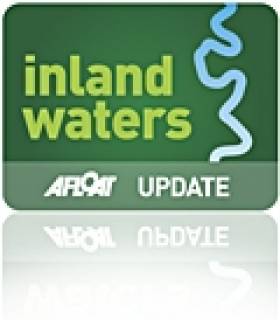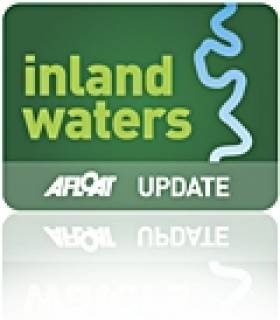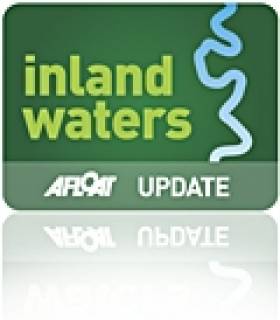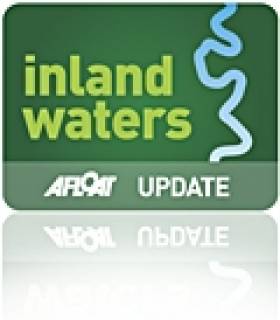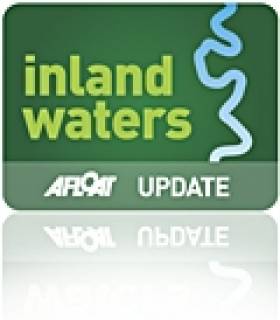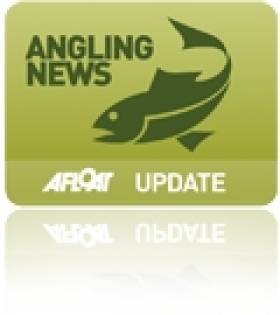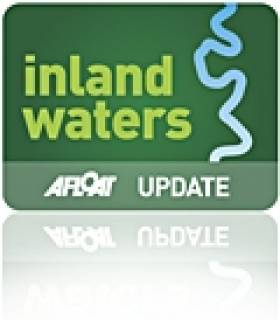Displaying items by tag: Waterways Ireland
Report Finds Emerald Star Line Cruiser Ran Aground on Rocks
The Marine Casualty investigation board has issued its Report of Investigation into the grounding and subsequent foundering of an Emerald Star Line Caprice 8, a Charter boat, The boat ran aground on rocks in the vicinity of Mountaineer Rock, off Ryan's Point on Lough Derg, Co. Tipperary last October 9th. The four persons on board were taken off by the Portumna Fire and Rescue RIB and ferried across the lake to Williamstown Harbour. The vessel was noted to have been severely holed. The vessel was pulled off the rocks and subsequently sank while under tow. There were no fatalities and no pollution associated with this incident. A copy of the report can be downloaded below.
200 Dinghies on Lough Ree for Optimist Championships
Waterways Ireland has issued an advisory to all masters and inland waterways users of the Shannon Navigation that the National Optimist Dinghy sailing event involving junior sailors will take place in and about Lough Ree Yacht Club (LRYC) on Sat 17th and Sun 18th July 2010 . Upwards of 200 sailing dinghies will be participating and will be making their way from LRYC to the racing course and back, on the southern part of Lough Ree.
Masters of vessels and boat are requested to proceed at slow speed and with minimum wash when passing the sailing fleet and to note any instructions or advice given by safety boats marshalling the race.
Athlone Boat Club Regatta Takes Place this Saturday
Athlone Boat Club on the inland waterways will hold their annual regatta at Coosan Point, Athlone on Sat 26th. Jun 2010 from 08.00 hrs until 19.00hrs. Waterways Ireland requests Masters of vessels, boats and Personal Water Craft to note the advice of course marshals when passing near the course and to proceed at slow speed and with minimum wash so as not to upset racing boats with very low freeboard.
Shannon One Design Sailing Race from Athlone to Portumna
Waterways Ireland advises the Shannon One Design annual long distance sailing race on the inland waterways will commence at 10.00 hrs on Sat 26th from Athlone Lock, overnight at Banagher and finish at Portumna Bridge on Sun 27th Jun 2010. The Shannon Inspector of Navigation has warned masters to give way to vessels and boats navigating by sail only. Full notice is attached.
New Grand Canal Route Opens
A route that follows the Grand Canal on the inland waterways being opened today provides access for walkers and cyclists from West Dublin right into Dublin centre. Details of the new route – that cost Euro 25 million – is in this morning's Irish Times by Paul Cullen here.
Channel to Close on Lough Erne
Waterways Ireland Wins O2 Ability Award
Waterways Ireland has won the coveted O2 Ability Award for Environmental Accessibility for its work on inland waterways at an awards ceremony last evening in the Royal Hospital Kilmainham. The awards were presented by Ryan Tubridy, RTE and Caroline Casey founder of Kanchi, the company responsible for the awards. Awarded to public and private sector organisations with exceptional commitment to ensuring accessibility for all, there are also awards for leadership, retention, customer service, learning and development and recruitment.
Accepting the award on behalf of the staff of Waterways Ireland, John Martin, Chief Executive said ‘Waterways Ireland (pictured left below) has from the beginning integrated accessibility into our policies and our activity. Waterways Ireland is committed to working continuously to ensure that enjoyment of the waterways is a choice rather than issue of accessibility”

Caroline Casey founder of Kanchi stated “ The O2 Ability Awards honour leaders and organisations that recognise the ability of people with disabilities and value the role they play in their businesses. They promote a business culture that seeks, respects, values and harnesses difference for the benefit of both business and society. Well done, Waterways Ireland”
Waterways Ireland is a North/South body and is responsible for the management, maintenance, restoration and development of the inland navigable waterways for recreational purposes. Waterways Ireland manages over 1000km of waterway under its remit, many kilometres of it built over 300 years ago. Waterways Ireland’s accessibility policy has ensured accessibility built into every project since inception. The outcomes have been the installation of 1000’s of metres of accessible jetties and numerous service blocks with no barriers to persons with disability.
Waterways Ireland through its sponsorship programme has ensured that activities are open to all and through a comprehensive customer services programme has ensured that customers receive a high level of service regardless of whether the point of contact takes place at a lock, or in an office or waterside location.
Powerboat Racing on Upper Lough Erne
Powerboat Racing will take place at the Derryad Powerboat Club, Lisnaskea on Ireland's inland waterways on Sun 16 May 2010 from 11.00 hrs to 19.00 hrs. Through traffic will be catered for via the west side of Inishrath Island i.e on the Geaglum moorings side of the navigation. Masters of vessels are requested to proceed at slow speed and with minimum wash when passing this stretch of the navigation and to heed any advice or instructions issued by the race officials.
Waterways Ireland Fishing Festival Launched
The Launch of the Waterways Ireland Classic Fishing Festival takes place yesterday Friday 23 April 2010 in advance of the competition which runs from Sunday 25 April to Friday 30 April 2010. This year’s Classic Fishing Festival is the 35th anniversary event, cumulatively hosting over 12,250 anglers. Though it must be said most of them have come year after year, in total they have spent over £17,500,000 in the Lakeland County since 1976.
The 2010 event welcomes competitors at a reception taking place on Sunday 25 April, with the competition begins on Monday 26 April and the Festival closes with a Gala Farewell and Prize Presentation on Friday 30th April.
The Waterways Ireland Classic Fishing Festival is the main event of the Fermanagh match fishing season and attracts up to 250 anglers from Northern Ireland, the Republic of Ireland, Great Britain, Germany, Austria and even further afield.
Over the five days, anglers will compete for prizes worth more than £20,000, with section and daily prizes on offer along with aggregate prizes. The “Classic Competition” takes place on Monday, Wednesday and Friday with the “King of the Erne”, organised by the local Erne Anglers Angling Club, completing the Festival on Tuesday and Thursday.
Among the 250 eager anglers lining up at the Fermanagh Lakeland Forum on Monday morning will be last year’s winner, Andrew Chapman from Ballybay, Co Monaghan. He is to be joined by twelve other previous winners, including Kevin Ashurst, who won the Classic in 1978.
Organised by Fermanagh District Council, with assistance from the Department of Culture, Arts and Leisure, the Festival’s major sponsor for the last seven years has been Waterways Ireland, the navigation authority on the inland waterways of which Lough Erne is one.
Martin Dennany Director of Marketing & Communications Waterways Ireland said’ The Waterways Ireland Classic Fishing Festival is a major joint activity which Waterways Ireland supports in partnership with Fermanagh District Council.
Speaking at the Press Launch for the 2010 Waterways Ireland Classic Fishing Festival, Chairman of Fermanagh District Council, Councillor Robert Irvine stated: “The Classic, now running for thirty five years, is one of our longest established events here in Fermanagh and we are delighted to once again welcome the many anglers who make an annual pilgrimage to our Lakeland County”.
Anglers can apply before the event by contacting Fermanagh District Council, Town Hall, Enniskillen, Co. Fermanagh, BT74 7BA or by calling +44 (0)28 6632 5050.
A Taste of the Waterways – Favourite Places to Eat & Drink, 2010
If you’ve never spent a few days lazing around our wonderful inland waterways you just don’t know what you’re missing. It’s a magical world of pottering along, enjoying the wildlife and exploring the unfolding countryside - just sooo relaxing… especially when you have Georgina Campbell’s A Taste of the Waterways guide to hand, to ensure you find all the best pubs and restaurants along the way. You don’t have to set foot in a boat to enjoy the hospitality along our waterways, but it would be a pity to miss out – especially when you have the guidance of a plethora of Waterways Ireland publications and this little gem, written jointly by Georgina Campbell and boating expert W. M. Nixon (sailing Correspondent with the Irish Independent and Contributing Editor of Ireland Afloat magazine).
Published in association with Waterways Ireland, the independently assessed 68-page guide leads visitors along all of our navigable waterways, and to nearly 100 great hostelries and restaurants sprinkled from Limerick up the mighty Shannon via Lough Derg, Lough Ree and the Shannon-Erne Waterway, to Lough Erne; and from Dublin out west along the Royal Canal and the Grand Canal – which also links southwards to the beautiful River Barrow. It’s a world apart and, using this guide and other Waterways Ireland publications such as the ‘What’s On’ guide, you’ll find there’s something for everyone, of all ages.
A Taste of the Waterways is available without charge from Tourist Information Centres and Visitor Attractions along the waterways, and is also distributed to over 60 hotels. To obtain this free publication online, visit www.ireland-guide.com or www.waterwaysireland.org


























